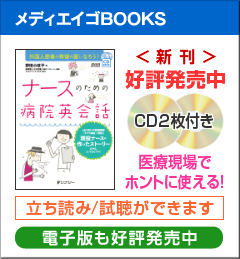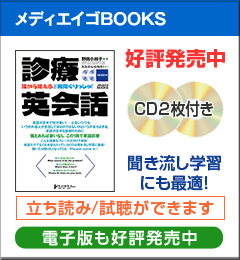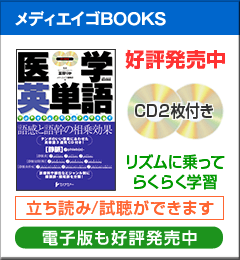

医学にも詳しいバイリンガル・パーソナリティのスマイリーが,ホットな話題を英語のニュースリリースを元に紹介する音声(ポッドキャスト)番組です。完全なネイティブではない,ちょっとくせのあるパワフル英語がやみつきになるかもしれませんよ。番組で取り上げるニュースリリースの全文も掲載しているので,ぜひご活用ください。
英語と日本語のチャンポンで不定期にお届けします。
Please enjoy this bilingual news program!
※iPhone, iPadでは「Download」をタップすると音声が出ます。
Jan. 11, 2013
No. 7
米国心臓協会年次学術集会より:心停止の低体温療法は目標32℃で転帰が改善
院外心停止患者の自己心拍再開後の低体温療法(目標32℃)で6カ月後の転帰が改善
|
Get the Flash Player to see this player.
|
 |
・cardiac arrest:心停止
・therapeutic cooling:低体温療法
・32 degrees Celsius:摂氏32度
【番組で取り上げた英文】
Cooling patients resuscitated after sudden cardiac arrest to lower body temperatures may be associated with increased survival and better functional ability.
Once a normal heartbeat is restored, treatment for comatose patients includes therapeutic cooling to decrease the body's oxygen requirements, which can help prevent brain damage associated with the cardiac arrest.
In the study of 36 people in Madrid, Spain, researchers found that 44 percent of patients who underwent therapeutic cooling to 32C after cardiac arrest survived without severe brain dysfunction six months after treatment. That compared to 11 percent of those cooled to 34C.
Although the results suggest a better outcome with lower levels of target temperature, they should be interpreted with caution. Since extremely low temperatures below 30C are associated with complications, it's critical to know the optimal level of cooling.
【ニュースリリース全文】 ※番組で取り上げた箇所は太字になっています。
News Release from American Heart Association on November 6, 2012
Cooling cardiac arrest patients to lower body temps improved survival
LOS ANGELES, Nov. 6, 2012 -- Cooling patients resuscitated after sudden cardiac arrest to lower body temperatures may be associated with increased survival and better functional ability, according to late-breaking clinical trial research presented at the American Heart Association's Scientific Sessions 2012.
The full manuscript for Pilot Trial of Two Levels of Hypothermia in Comatose Survivors from Out-of-Hospital Cardiac Arrest, is published in Circulation, a journal of the American Heart Association.
In the study of 36 people in Madrid, Spain, researchers found that 44 percent of patients who underwent therapeutic cooling to 32C (89.6F) after cardiac arrest survived without severe brain dysfunction six months after treatment. That compared to 11 percent of those cooled to 34C (93.2F).
Researchers defined dysfunction as the inability to perform the normal tasks of everyday living, including bathing, dressing and walking.
Each year in the United States, about 382,800 people suffer cardiac arrest outside of a hospital, according to the American Heart Association. The life-threatening condition occurs when the heart suddenly stops functioning. Immediate CPR and emergency medical care must be provided within minutes to restore a regular rhythm - or the person will not survive.
Once a normal heartbeat is restored, treatment for comatose patients includes therapeutic cooling to decrease the body's oxygen requirements, which can help prevent brain damage associated with the cardiac arrest. American Heart Association and International Liaison Committee on Resuscitation (ILCOR) recommendations are to cool body temperature to 32C-34C, but the optimal temperature within this range is unclear.
"Although the results suggest a better outcome with lower levels of target temperature, they should be interpreted with caution," said Esteban Lopez-de-Sa, M.D., lead researcher and head of the Cardiac Critical Care Unit and Clinical Cardiology at La Paz University Hospital in Madrid, Spain. "They may be due to multiple factors other than the effect of lower target temperature."
The benefits were observed in patients whose initial detected rhythm was shockable, he said.
Thirty-six patients with out-of-hospital cardiac arrest participated in the single-center trial, from March 2008-August 2011. Their average age was 64, 89 percent were male, and all were white.
Researchers randomly assigned patients to receive therapeutic cooling to either 32C or 34C for 24 hours, followed by gradual rewarming for 12-24 hours. Patients were cooled internally with intravenous cold saline followed by an internal catheter and temperature management system inserted directly into the main vein from the lower body to the heart.
"Since extremely low temperatures below 30C are associated with complications, it's critical to know the optimal level of cooling" Lopez-de-Sa; said. "The aim of the study was to provide initial information for future research about whether controlling hypothermia levels can improve outcome."



